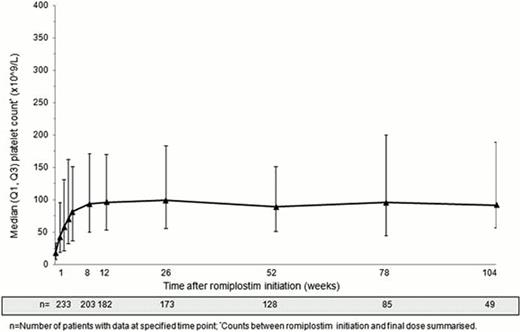Abstract
Abstract 3316
ITP is characterized by platelet counts <100 × 109/L, with counts <10–30 × 109/L predictive of serious and fatal bleeds (Provan et al, Blood 2010; Portielje et al, Blood 2001). The thrombopoietin-receptor agonist (TPOra) romiplostim is recommended for second-line treatment of adult ITP, where the treatment goal is sustained increases in platelets counts (Provan et al, Blood 2010). Registration studies of romiplostim were conducted in selected patient (pt) populations, and may not reflect clinical practice.
This ongoing study enrolls ITP pts ≥18 years old, who have received romiplostim in clinical practice in Austria, Belgium, Czech Republic, France, Greece, Portugal or Sweden. Pts participating in another study, who initiated romiplostim prior to commercial launch, or received other TPOra or related products are excluded. Data recorded as per clinical practice, including concomitant medications, is collected for up to 2 years following romiplostim initiation. Study outcomes include pt characteristics (at romiplostim initiation), romiplostim dose, adverse drug reactions (ADRs) and bleeds, summarized for pts meeting the study eligibility criteria (Full Analysis Set; FAS). Grade 3 or 4 bleeds are classified using the WHO bleeding scale. The study, and medical writing assistance for this abstract, was funded by Amgen (Europe) GmbH.
As of February 2012, 237 (96%) of 248 pts enrolled were included in the FAS. Of these, 60% (143/237) remained on study, 29% (69/237) had completed the 2 year observation period and 11% (25/237) had withdrawn, with death the most common reason (17/237 [7%]). At romiplostim initiation, median (Q1, Q3) age, weight and platelet count were 62.0 (46.0, 74.0) years, 74.00 (63.00, 85.00) kg and 18.0 (8.0, 34.0) × 109/L; 33% (79/237) of pts were splenectomised, 54% (129/237) female, 32% (77/237) had been diagnosed with ITP for < 1 year (median [Q1, Q3] time from diagnosis, 3.63 [0.42, 11.59] years), and 54% (128/237) had received ≥3 prior ITP therapies. Thirty-one percent (74/237) of pts stopped romiplostim before the end of the observation period, with requirement for alternative therapy (22 [9%] pts), hemostatic platelet counts/no further treatment necessary (11 [5%]), ADR (8 [3%]) and death (6 [3%]) the most common reasons. Median (Q1, Q3) duration of romiplostim exposure was 53.6 (22.6, 94.0) weeks (maximum 106 weeks); median (Q1, Q3) observation following romiplostim initiation was 18.75 (12.20, 24.10) months. Taking the average weekly dose of all pts, the median (Q1, Q3) was 2.8 (1.5, 4.3) μg/kg/week. Median platelet counts rose rapidly during the first 4 weeks of romiplostim treatment and remained >50 × 109/L thereafter (approximately 2 years; Figure). Grade ≥ 3 bleeds were rare following romiplostim initiation (Table). The most commonly reported ADRs were headache, thrombocytosis, arthralgia, asthenia, flushing and myalgia (2.0–5.9 events per 100 pt-years). Five pts reported a total of 8 serious ADRs: 2 events each of pulmonary embolism and myelofibrosis (initial diagnosis inconsistent with ITP, myelofibrosis more likely due to the underlying disease [MDS, metastases to bone marrow]); 1 event each of deep vein thrombosis, drug ineffective (clinical symptoms, thrombocytopenia), platelet count decreased (platelets <20 × 109/L), and (reversible) thrombocytosis (1 event, platelets 477 × 109/L).
Platelet counts
Grade ≥3 Bleeds*
| . | Full Analysis Set (N=237) . | |
|---|---|---|
| Before rom initiation . | After rom initiation . | |
| Pts reporting at least 1 bleed†, n (%) | 11 (5) | 4 (2) |
| Number of bleeds | 13 | 5‡ |
| Pt-yrs of observation | 95 | 332 |
| Rate per 100 pt-years | 13.7 | 1.5 |
| Number (%) occurring at platelet ≤30 × 109/L§ | 11 (85) | 5 (100) |
| . | Full Analysis Set (N=237) . | |
|---|---|---|
| Before rom initiation . | After rom initiation . | |
| Pts reporting at least 1 bleed†, n (%) | 11 (5) | 4 (2) |
| Number of bleeds | 13 | 5‡ |
| Pt-yrs of observation | 95 | 332 |
| Rate per 100 pt-years | 13.7 | 1.5 |
| Number (%) occurring at platelet ≤30 × 109/L§ | 11 (85) | 5 (100) |
rom, romiplostim;
Collected for up to 6 months before and 2 years after rom initiation; Percentage calculated from number of
pts,
events;
3 events occurred after last rom dose.
With similar doses as previously reported (Kuter et al, Blood 2008), and no new safety signals, pts with ITP of varying duration and severity receiving romiplostim in clinical practice achieved sustained increases in platelet counts and a reduction in grade ≥3 bleeds. Incomplete reporting before romiplostim initiation and a shorter observation period may have led to an underestimation of the number bleeds during this period; hence the true reduction in grade ≥3 bleeds following romiplostim initiation may be greater than reported here.
Selleslag:Amgen: Consultancy, Membership on an entity's Board of Directors or advisory committees, Research Funding, Speakers Bureau. Janssens:Amgen: Consultancy, Membership on an entity's Board of Directors or advisory committees, Speakers Bureau. Wadenvik:Novartis, BMS, GSK, Amgen, Alexion: Consultancy. Steurer:Amgen: Consultancy, Honoraria. Kaiafa:Amgen: Consultancy, Honoraria. Kozak:Amgen s.r.o.: Membership on an entity's Board of Directors or advisory committees. Viallard:Amgen: Honoraria, Membership on an entity's Board of Directors or advisory committees. Dillingham:Amgen: Employment, Equity Ownership. Kreuzbauer:Amgen: Employment, Equity Ownership.
Author notes
Asterisk with author names denotes non-ASH members.


This feature is available to Subscribers Only
Sign In or Create an Account Close Modal